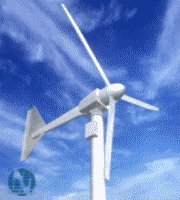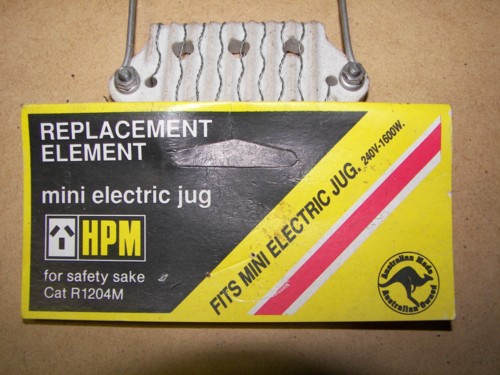
|

|
Forum Index : Windmills : 24 volts water heater elements
| Author | Message | ||||
| e1campo Newbie Joined: 01/09/2008 Location: AustraliaPosts: 3 |
I just set up a 24 volts solar system,350 watts,with a 670amps 24 volts battery bank with a PL40-7amp regulator and I realize that the system needed more input power so I bought a 500 watts windmill with a regulator my question is the following: can I connect the windmill to the battery bank through its own regulator or I have to do different. The second question is : how can I go doing a 24 volts water heater element to use the excess electricity produced by the system when the batteries are fully charged farmer |
||||
| davef Guru Joined: 14/05/2006 Location: New ZealandPosts: 499 |
Because 12V and 24Volt heater element seem to be rather rare, what I found for someone else, was a 12kW 230Volt heater element. With 56Volts across it, the element dissipated somewhere around 700Watts. P(Watts) = V (Volts) * I (Amps) So, I = P / E or 12000W / 230V = 52.2 Amps R (Ohms) = Volts / Amps So, R = 230 / 52.2 = 4.4 Ohms Now, with 56Volts across 4.4 Ohms Amps = 56V / 4.4 Ohms = 12.72Amps Lastly, P = Volts * Amps or P = 56 * 12.72 = 712 Watts You should be able to work out what value in KW, the 230Volt heater element you would need for your system. Then you just need something to sense when your battery voltage gets to the value where you want to stop charging it and use that to operate a BIG relay. Put some hysteresis or "dead band" in your controller so that you don't wear the relay out too quickly. The other guys around here may know of an appropriate bit of hardware you could use. Think one of things you do not want to happen is for there to be NO load on your wind at any time. Good luck, davef |
||||
Gill Senior Member Joined: 11/11/2006 Location: AustraliaPosts: 669 |
G'day e1campo, Sounds like a good little setup you've got there. The windmills regulator will have a dump load feature on it. It's just a matter of substituting your water heater for the existing load. davef has given you figures for a 48volt system. His load would dump 1/2 that power in your 24volt system. About 306 Watts which is spot on for your 300W mill. His formula are sound though so work off them. Considering the size of both inputs, it is essential you run both the solar and wind regulators. I'm sure they will both not be set to work at the exact same battery voltage, but that's not a problem. was working fine... til the smoke got out. Cheers Gill _Cairns, FNQ |
||||
| e1campo Newbie Joined: 01/09/2008 Location: AustraliaPosts: 3 |
thanks for the information but for my calculations i will need a water heater of 24 Kw and they are very expensive, would anybody around have the information on how to make one that suit my needs or if I connect lower wattage elements in parallel I can get what I am looking for farmer |
||||
Gill Senior Member Joined: 11/11/2006 Location: AustraliaPosts: 669 |
How about using electric jug elements? The instructions on how to modify them to suit are in this download from Oatley Electronics. HERE You will need to calculate for your values but you have the formula.  was working fine... til the smoke got out. Cheers Gill _Cairns, FNQ |
||||
| davef Guru Joined: 14/05/2006 Location: New ZealandPosts: 499 |
Yes, you could put jug elements in parallel, in the case 12 of them! Now, this article from Oatley about using the wire from jug elements. Are they suggesting putting the bare element straight into water? I asked this question on the 31stMar, and didn't get an answer . . . wouldn't there be a problem with hydrolysis by having the element exposed to the water? Anyone tried it? |
||||
Gill Senior Member Joined: 11/11/2006 Location: AustraliaPosts: 669 |
G'day daveft, Yes, put the element in the water or fan cooled in the air works OK too. The ceramic formers are made for water immersion and made for 240Volts so quite up to the job. I don't know about 12 jug elements though. Seems a lot to me. I'm not going to do the maths for you. You'll never learn that way. I expect you will need to lengthen the wire to suit 24 Volts. I'm sure you'll figure it out in the end. 
was working fine... til the smoke got out. Cheers Gill _Cairns, FNQ |
||||
| davef Guru Joined: 14/05/2006 Location: New ZealandPosts: 499 |
Sorry, I need to clarify, "by bare element" straight into the water, I meant the actual wire with 24Volts on it, ie no insulation between it and the water. |
||||
Gill Senior Member Joined: 11/11/2006 Location: AustraliaPosts: 669 |
davef, confirming: Yes, put the element in the water. Now that's bare element straight into the water. Here's the element type in question with one of my spares. This is as per the instruction and 4 of these are the dump load of a 12Volt 300Watt wind turbine. 
This pic clearly shows the element is 240Volt 1,600Watts as purchased and for bare immersion in water. 
You young fellows have been spoilt by electric kettles that turn themselves off. In my day we had to clean up the mess when the jug boiled over.   was working fine... til the smoke got out. Cheers Gill _Cairns, FNQ |
||||
| e1campo Newbie Joined: 01/09/2008 Location: AustraliaPosts: 3 |
dear Gill thank you for calling me youngster, but as a 67 year old youngster I learn to heat water in the old kettle over a "Primus" heater, I would like to know if the elements have to be connected in parallel [ the elements I have are the same as in the photo 240 volts 1600 watts] do I have to use a diode and if i have which thanks agaian to both of you I have been learning a lot. farmer |
||||
oztules Guru Joined: 26/07/2007 Location: AustraliaPosts: 1686 |
Gill, Just an observation, when I pumped 5kw into the icecream container, I got mountains of bubbles from the boiling water, but also got a green ooze and froth from the electrolysis on the copper alligator clips (jumper leads) holding the coils. If it were AC then I don't see a problem (taking and putting at say 50hz on each electrode... so neutral, but with DC, my clips would have not lasted too long at high voltage high current (over 140v@over 35A). At lower voltages this may not be as severe as fast, but would sooner or later make itself apparent I think.... maybe? .........oztules Village idiot...or... just another hack out of his depth |
||||
Gill Senior Member Joined: 11/11/2006 Location: AustraliaPosts: 669 |
e1campo, I am aware both you and davef have quite a few years on me so thought to edit out the young fellow comment but decided not to as that gave it a tongue in cheek humour. Yes, off the top of my head, I expect you will have 4 in parallel though the modified wire length for each may be twice that of the 12 volt example. I have deliberately avoided working out your element arrangement preferring you to do it for yourself. No diode will be needed if the heating element is wired as a substitute for the factory load in the shunt regulator. There should be a blocking diode for the solar panels though I expect these would have already been fitted to stop sunlit panel feeding through shaded ones as is standard practise on most installations. If not fit a blocking diode with a current capacity that exceeds your max possible output from the panels. 350 Watts of panels divided by 24 Volts = 14.6 so say any above 15 Amps will do but better to go much higher. The diodes will likely be called rectifier diodes in the store. Oztules, Thanks for the input. I never noticed any electrolysis with the test I did, though I did have the wire connections out of the water and never put in the power to make water boil. As you say, some effect may make itself apparent over time. was working fine... til the smoke got out. Cheers Gill _Cairns, FNQ |
||||
| GWatPE Senior Member Joined: 01/09/2006 Location: AustraliaPosts: 2127 |
the electrolysis occurs if the element is not insulated. Remember the elements are originally designed for AC. If you use DC, and uninsulated then current will also flow through the water as well as the wire. One end of the wire will be disolved and the other will be plated. I would use Au, or Pt, but would need a lot HaHa. Either use AC, or insulate the wire for best lifetime of the wire. Gordon. become more energy aware |
||||
| The Back Shed's forum code is written, and hosted, in Australia. | © JAQ Software 2025 |